Are you looking for the best outreach tool to drive your campaigns? Wondering which email outreach tools to evaluate for your business?
FACT: Email outreach campaigns are about sending targeted emails to specific recipients to drive the desired action.
There are lots of possible “actions” you could be aiming to drive, such as:

- Adding a backlink from their site to yours
- Buy your product
- Getting press coverage for your business
- Landing guest spots on podcasts
- Finding new affiliate partners
- Download your new ebook
- Attend your next webinar
- Register for a demo request
- Recommend your product
- Invest in your business
Whatever the goal of your cold email outreach, getting it right is definitely good for business.
Yet only 8.5% of outreach emails ever receive a response.
That means if you’re going to get results at scale, you’ve got two options:
- Hire a dedicated outreach team to do manual prospecting, write all the copy, send messages, and follow up on previous emails
- Find the best email outreach tool to automate some (or all) of those crucial processes
Obviously, I’m biased, but I firmly believe option two is the smarter choice. It’s faster, it’s more scalable, it’s more efficient, and it’s much cheaper. But only if you choose the right email outreach tool — one that perfectly fits the needs of your business.
In this article, I’m going to talk through the features you should look for and dive into the 30 best tools for email outreach on the market right now.
Features to Help You Find the Best Email Outreach Tool
1. Is This An All-in-one Tool?
Some cold email softwares provide an all-in-one solution, handling everything from the initial prospecting stage to crafting personalized copy, scheduling messages, and managing leads. Far better to choose a cold emailing tool that does it all (for a fixed monthly fee) than to rely on multiple platforms and processes.
2. Does It Have Built-in CRM?
Email outreach is only the start of the process. Once you’ve sent your messages and started receiving replies, you need to manage the relationship with your prospect or contact. To do that, you need a built-in customer relationship management (CRM) system. Sadly, not a lot of outreach tool comes with a CRM.
3. Can It Scrape Verified Emails?
You need verified email addresses to perform effective email outreach; otherwise, you’ll waste time sending targeted messages to dead or inactive accounts. That’s why you should choose a solution with a built-in email verification tool.
4. How Well Can It Be Automated?
The whole point of choosing a cold email tool is to reduce the manual burden on yourself or your team. The more elements of the outreach process are automated, the less time you’ll have to spend on low-value, labor-intensive tasks like adding names to your CRM and scheduling messages.
5. Is the Email Outreach Software Easy To Learn?
There are two key milestones in a customer’s journey with a new piece of software:
- When they first sign up
- When they achieve their first “success”

If you choose an email outreach tool that’s too complicated, it’ll take too long to achieve that first success; uptake will be low; and your team will fall back on old, inefficient processes.
6. How Well Can You Personalize Emails?
Personalization is absolutely vital to high-performing email outreach campaigns, with research from Backlinko revealing:
- Personalized subject lines boost response rate by 30.5%
- Emails with personalized message bodies have a 32.7% better response rate than those without personalized messages
If your chosen cold email software doesn’t make it easy to craft personalized emails, it won’t deliver the best results.
7. What Does It Specialize In?
While there are plenty of good “all-rounders” out there, to some extent every email outreach tool has some kind of specialism. Define the result you’re hoping to achieve through email outreach — connecting with people on LinkedIn? Driving sales? Link building? — then choose the most appropriate tool for the job.
8. Any Unique Features?
Some email marketing tools have unique, non-standard features that set them apart from the competition. For instance, Postaga’s AI content analyzer identifies outbound links, key contacts, and information to include in your emails, making them more personal, and increasing your chances of success.
Are those unique features a deal-breaker, or merely a nice-to-have?
What Are the Best Email Outreach Tools?
1. Postaga.com

Pros
Again, I’m biased, but I firmly believe there’s more than enough evidence to declare Postaga the all-round best email outreach tool.
We have more features than any of our competition, including cool stuff like:
- AI-driven campaign ideation
- An opportunity finder tailored to the goals of your email outreach campaign
- A contact finder to quickly locate the email and social media information for key prospects
- Automated personalization to make each email unique to the recipient
- Postaga has a built-in CRM to manage your outreach campaigns.
We built Postaga as an all-in-one solution. “All-in-one” means there’s no need for additional third-party tools that do things like prospecting, email warm-up, or email verification. And we support all the popular email clients, including Gmail, G Suite, Outlook, Exchange, and SMTP.
Cons
Postaga currently doesn’t include a personal prospect database, though it is on the roadmap.
And image personalization isn’t built-in natively, although it is possible via integration with Nexweave.
2. Hunter.io

Pros
Hunter isn’t a complete email outreach tool, and nor does it claim to be. Instead, it specializes in helping you find professional email addresses for the prospects you’re trying to reach.
Its Domain Search feature is a powerful tool that provides a list of the people working in a company along with their name and contact details, powered by a database of 100+ million email addresses.
Cons
Hunter’s biggest strength is also its greatest weakness. You can use it to run up to 25 email address searches a month and deliver very simple outreach campaigns free of charge. But if you need any further functionality, you’ll need to pay for at least one additional email automation tool.
3. Buzzstream
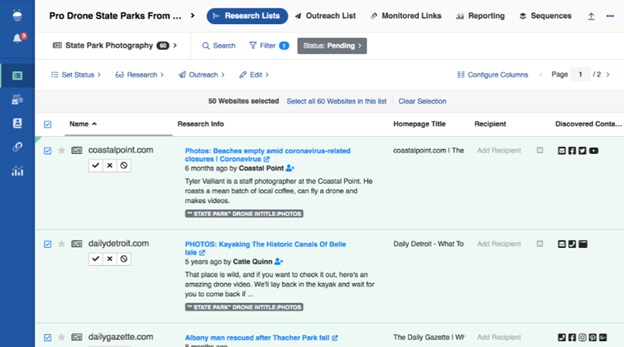
Pros
Buzzstream is another strong all-rounder packed with powerful features. Its prospecting tools allow you to add new bloggers, websites, and social profiles to your database as you browse the web, and instantly turn any SERP or list of URLs into a prospect list. Plus its management and reporting tools make it easy to keep your cold email campaigns on track and draw insights to guide future strategy.
Cons
Buzzstream’s targeting options could be better. The workflow requires a bit of manual effort to sift through your outreach prospects, and it doesn’t do location targeting at all.
Also, it’s very much built with PR and blogger outreach in mind — so if you’re looking for a sales outreach tool, Buzzstream’s not the one.
4. Overloop

Pros
Formerly known as Prospect.io. The Overloop is a free CRM platform with built-in pipeline management features that, unsurprisingly, include email outreach functionality. Its email tools allow customers to handle inbound and outbound sales conversations from within the CRM. With variables and custom fields, users can easily personalize emails by adding the prospect’s first name, last name, company name, or any other information at the click of a button. And it has a built-in email finder and verifier.
Cons
Overloop isn’t the cheapest option on the market. While the outreach tools CRM is free, if you need things like email automation, tracking, custom fields, and the email finder, you’ll be paying $79 per month plus an additional $29 per user.
5. Snov.io

Pros
Snov.io is designed to help your sales team reach more prospects and close more deals through the power of automation. Suitable for both inbound sales and outbound sales, its tools cover the full spectrum of the sales process, from generating, verifying, and nurturing prospects to researching leads (and your competitors) to craft a more compelling pitch.
Cons
Snov.io is great for sending sales emails, but it’s not set up to deliver other types of cold outreach campaigns. Look elsewhere if you want a tool that also does link-building and PR outreach.
6. Respona

Pros
Respona streamlines the process of building cold email campaigns for link-building. Built-in email templates, contact discovery, and personalization tools help you craft engaging email drip campaigns in minutes. It also offers a full 30-day refund guarantee, so if you’re not satisfied after using it, you can get your money back.
Cons
First off, Respona isn’t meant for sales outreach. Second, it lacks some of the functionality of other link-building outreach tools, such as location targeting and a built-in email warmup feature. And there’s no built-in CRM for lead management.
7. Yesware

Pros
Yesware is an all-in-one inbox tool for sales engagement. Email tracking and link tracking functionality instantly notifies you when a recipient opens your email, clicks a link, or views an attachment. And it’s easy to build multichannel campaigns combining automated follow-ups, manual emails, call touches, LinkedIn InMails, and other custom touchpoints.
Cons
With prices ranging from $15 – $65 per user, it can work out pretty expensive once you scale your team. Also, Yesware lacks some of the features you need to build a list of prospects, such as an email verifier.
8. Ninja Outreach

Pros
Ninja Outreach is an influencer marketing platform with a built-in blogger outreach tool.
Its real specialty is in finding relevant social media influencers. Having found the right influencers, Ninja helps you build an automated cold emailing campaign based on previously written cold email templates, including up to two automatic follow-ups.
Cons
While its influencer search function is fantastic, Ninja Outreach isn’t the best email outreach tool when it comes to running outreach campaigns. And obviously, if influencer marketing isn’t what you’re looking for (or is only a small part of your business), Ninja isn’t the right fit.
9. SmartReach.io

Pros
Primarily a sales outreach tool, SmartReach.io allows you to add leads from a CSV, your CRM, or LinkedIn; build drip email campaigns with automated follow-up emails; and sync all activity to your CRM.
Its email deliverability features are impressive, strengthening your IP, domain, and email to improve your chances of reaching the primary inbox of your potential customer rather than the junk folder.
Cons
As a cold email outreach tool, SmartReach.io is very much focused on sales; it’s not a great all-rounder. That means you’d need a whole other platform for tasks like blogger outreach and link-building. It also looks a little outdated compared to some of the more popular tool choices, although that’s not a big issue.
10. Reply.io

Pros
Although it’s predominantly targeted at sales teams, Reply.io can be used for everything from inbound and outbound sales to PR, link-building, and even HR and recruitment.
Its Chrome extension can run an email search on LinkedIn and Sales Navigator then add contacts directly to your email sequencing. And its proprietary AI email assistant helps you write human-like emails and follow-ups in seconds.
Cons
It’s not the cheapest email outreach tool on the market, with its sales engagement features priced from $70 per user per month for a team of three. Also, while it can handle non-sales-based email outreach, it lacks the dedicated functionality of a specialized blogger or PR outreach tool.
11. Pitchbox

Pros
Pitchbox is an influencer outreach and content marketing platform for brands, agencies, and publishers. It supports 20+ prospecting options, from guest posting to skyscraper outreach and everything in between. It also integrates with all the big SEO and link-building tools (think Ahrefs, Moz, SEMrush, and more).
Cons
Pitchbox offers customized plans rather than fixed prices, but it’s not cheap — expect to pay north of $6,000 per year. And once again, it’s not an all-rounder, so you’d need to shell out extra money for a cold email outreach tool your sales team can use. People have found out their emails were going straight to spam due to having no warm-up,
12. Klenty

Pros
Used by more than 4,000 companies including Lyft and Fitbit, Klenty is a sales engagement tool designed to help you get more replies and meetings from cold email outreach.
Prospects can be automatically targeted with different personalized campaigns based on the intent they display. Klenty uses formulas to help you create personalized campaigns fast and even lets you embed personalized videos in sales sequences.
Cons
As a sales outreach tool, Klenty is fantastic for prospecting and building email sequences. However, it’s short on some of the more creative stuff — like AI outreach suggestions and campaign generation — that’s so useful to executing effective blogger outreach campaigns.
13. Sales.Rocks
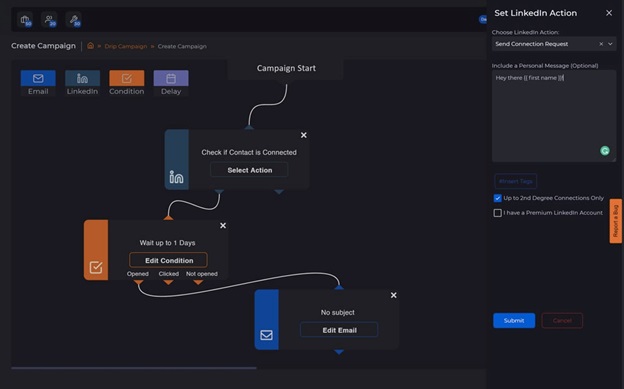
Pros
Sales.Rocks has a business database containing thousands of different sources of online data about contacts and companies worldwide.
However, it’s not just a source of valuable prospect data. The platform also lets you build automated drip email campaigns with customizable outreach templates while simultaneously engaging prospects on LinkedIn.
Cons
With prices starting at €700 per quarter for just one user and climbing to €2,610 per quarter for a 10-person team, Sales.Rocks definitely isn’t the cheapest email outreach tool. And while it’s billed as an all-in-one solution, the marketing functionality is geared toward lead generation rather than PR or link-building outreach campaigns.
14. Autoklose

Pros
Autoklose is a sales engagement platform with a large database of millions of clean, verified B2B contacts. Its email sequencing functionality allows users to A/B test email templates, save top-performing sequences, and invite other team members to use them. Plus it offers a 14-day free trial so you can get used to the platform before committing to a contract.
Cons
Again, while Autoklose is packed with useful functionality to support your sales team, it doesn’t offer anything for blogger outreach, PR campaigns, or link-building activity. It’s very good at what it does, but it’s not an all-rounder.
15. Lemlist

Pros
Lemlist positions itself as “sales automation and cold email software in one”, and it definitely has lots of features. Email marketers and salespeople can use it to personalize cold emails, automate follow-ups, and engage with leads across multiple channels. It’s also one of the cheaper email outreach tools, with prices starting at $59 per month per user for personalized email outreach campaigns.
Cons
Despite touting itself as an all-in-one solution, Lemlist lacks tools to help you find potential prospects. It’s great for link-building and sales generation campaigns but isn’t really suitable for PR outreach.
16. Mailshake

Pros
While it supports link-building and PR outreach, Mailshake is predominantly a sales outreach platform.
The tool makes it easy to send bulk emails while still adding text and links that are personalized to each individual recipient. Reply detection and email deliverability features allow you to pause sequences when a prospect replies, unsubscribes, or bounces, while reply rates can be improved by customizing your sending schedule around your prospect.
Mailshake is also comparatively cheap at $59 per user per month.
Cons
Mailshake doesn’t offer any prospecting functionality (other than a Pro-tier-level email verifier), so you’ll need to go elsewhere for things like email search and targeting. That means you’ll need at least one additional tool to run effective outreach campaigns.
17. Outreach.io
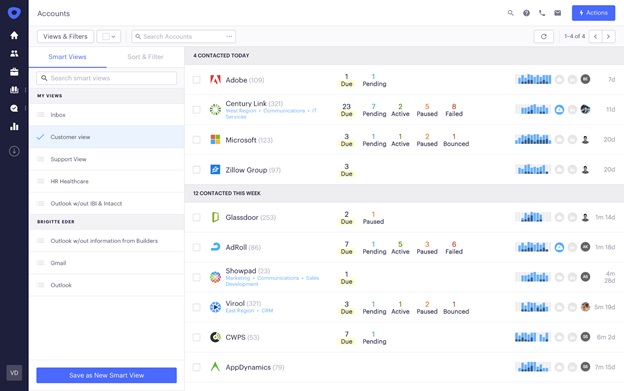
Pros
Outreach.io is another sales engagement platform with plenty of built-in automation. Ideal prospects can be managed via a single space then reached with personalized automated sales campaigns including voice and email follow-ups.
Cons
You’d think a platform called “Outreach.io” would be catered to all types of outreach, but you’d be wrong. While it can do inbound, outbound, and account-based sales, and even recruiting campaigns, it’s not cut out for acquiring backlinks, running PR activity, or doing blogger outreach.
18. Woodpecker

Pros
Woodpecker is a cold email tool for outbound sales and converting trial users into paying customers. Its advanced analytics tools allow you to track bounce rates, reply rates, click-through rate, and much more. And reply detection pauses automated follow-ups once you get a response from the user.
Cons
Woodpecker is exclusively a sales platform, so it’s unsuitable for things like blogger outreach and PR campaigns. It also lacks useful prospecting tools like email extraction and verification — so if they’re important to your outreach efforts, you’ll need to use a separate platform.
19. Salesmate

Pros
As the name suggests, Salesmate is a sales outreach tool designed for sending bulk emails and text messages.
Sales teams can save time with predefined email templates, send personalized emails, and track email opens and clicks to optimize campaign performance. Automated notifications mean you’ll know whenever prospective clients open your email or click a link.
Cons
While it doesn’t pretend to be an all-rounder, Salesmate’s lack of support for key email outreach activities like blogger outreach holds it back and means it’s not suitable for your entire team. That means your sales function, SEO team, and outreach specialists could all be forced to use separate platforms, which isn’t great for collaboration.
20. Persistiq

Pros
PersistIQ is an email outreach tool built for outbound sales teams at small businesses.
It’s designed to be lean, stripping away a lot of common sales enablement tools to leave a platform designed solely for creating and tracking cold email campaigns. It also boasts an email search tool capable of Automatically importing names, emails, titles, and more from LinkedIn Search or Sales Navigator.
Cons
Despite the limited feature set, PersistIQ isn’t especially cheap, with prices starting at $59 per user month. Its entry-level plan limits users to sending 300 emails per day, which might not be enough for some sales teams.
21. Vocus
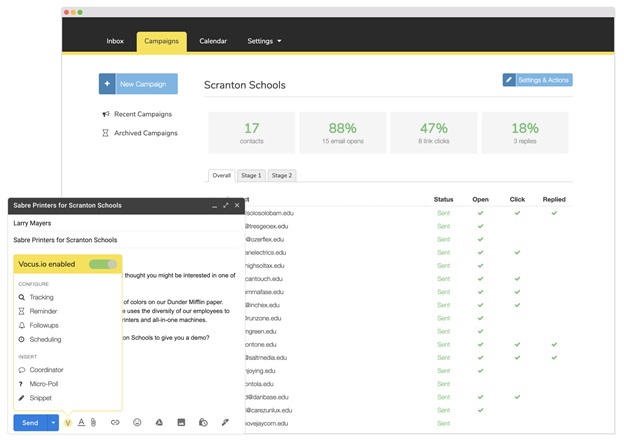
Pros
Vocus is essentially a giant Gmail add-on for sales, outreach, and marketing teams.
Mail Merges allow you to send hundreds of personalized emails from your name and email address, just as if you sent them manually. And it offers lightweight prospecting via its email search and validation tools.
It’s comparatively cheap, with prices starting at just $5 per month (although you’ll need to upgrade to the $20 per month Professional tier to run automated campaigns with follow-up emails). There’s also a 30-day free trial with no credit card required.
Cons
Vocus only supports Gmail and G Suite for Business, which means it doesn’t have mailbox integrations for popular email clients like Outlook, Exchange, and SMTP.
22. Quickmail

Pros
QuickMail is aimed at helping founders and agencies improve their email outreach reply rates by boosting email deliverability. Its free Auto-Warmer plan and built-in deliverability tools — including inbox rotation and variable sending delays — are designed to ensure your emails reach your prospective clients’ primary inboxes. And you can use multiple inboxes per campaign to spread the load across several inboxes, increasing your daily sending limit without risking deliverability.
Cons
QuickMail doesn’t have the prospecting functionality required to build a target audience for your campaigns; you’ll need to do that separately. It also lacks built-in personalization tools, making it harder to craft impactful messages.
23. Saleshandy

Pros
Another sales-focused outreach platform, Saleshandy lets you send personalized cold email campaigns with automated follow-ups and gauge the recipient’s behavior with unlimited email tracking.
It has dedicated extensions for Gmail and Outlook, making it simple to track each and every email from within your chosen email client. Saleshandy also offers a Chrome extension that lets you find and verify email addresses within LinkedIn.
Cons
Saleshandy is very good at what it does, but its feature set is pretty basic, with no prospect research tools or SEO metrics built in. As your outreach campaigns become more sophisticated, you’ll likely need something a little more advanced (like Postaga!).
24. Salesloft
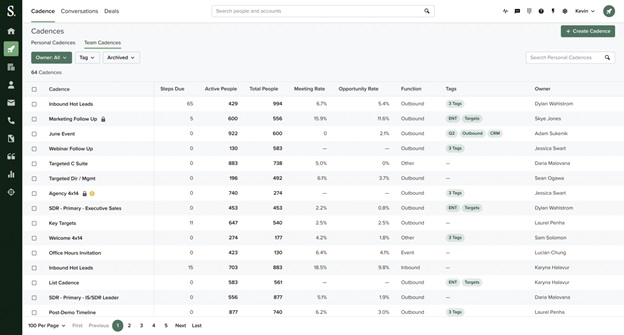
Pros
Salesloft is a sales engagement platform, which means it does a lot more than email outreach.
Email templates can be customized to send more personalized emails at scale, while integrations with tools like Vidyard, Seismic, and Videolicious allow you to embed personalized videos in your outreach messages.
Emails can be sent from inside the Salesloft platform, your preferred email service provider, or your CRM. Calendar syncing makes it easy to share your schedule and book meetings.
Cons
If you’re solely looking for a dedicated email outreach tool, Salesloft isn’t it. All that extra functionality comes at a cost, meaning Salesloft is pretty expensive (although you’ll have to contact them for a quote). It also lacks basic prospecting tools like an email finder and verifier as standard.
25. GMass

Pros
GMass is a mass emailer inside Gmail that’s achieved a 4.8-star Chrome Web Store rating from more than 6,000 reviews.
Working with an existing (or newly created) Gmail account, it allows users to send hundreds of personalized emails from a spreadsheet of prospects in just a few clicks. Follow-ups can be automated to drive conversions, while built-in analytics tools make it easy to see who has and hasn’t opened your emails.
It’s also pretty cheap, with prices ranging from $19.95 – $49.95 per month.
Cons
GMass has an obvious drawback: it’s a Gmail plugin, so if you prefer a different email client, it’s useless. Its prospecting tools are also pretty limited, beyond a built-in email verifier.
26. Sendpulse
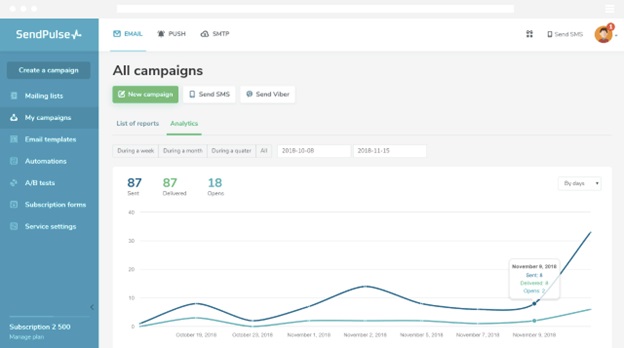
Pros
SendPulse is a multichannel marketing automation software, capable of handling everything from crafting bulk email campaigns to building landing pages and adding chatbots to your social media profiles.
It even comes with a free CRM to manage your sales process and communications from a single hub.
The drag-and-drop email editor makes it simple to create high-quality emails without any HTML knowledge or technical skills. Alternatively, users can choose from 130+ pre-built email templates.
Cons
SendPulse’s biggest problem is that it’s a generalist marketing tool rather than a specialist email outreach solution. The email personalization options are pretty basic and it doesn’t offer much in the way of prospecting tools, beyond a slightly clunky email verifier.
27. Traackr

Pros
Traackr app is a niche product that helps beauty brands and agencies deliver better results from influencer marketing — so if that aligns with your needs, it could be the tool you’ve been searching for.
Email is only a relatively small part of its feature set, but it allows you to send personalized emails to influencers, individually and en masse, and automatically track ongoing conversations for visibility across your team.
Its discovery tools are excellent, allowing you to search for influencers based on various criteria, such as mentions of your brand, competitors, topics of interest, and hashtags.
Cons
Just one: if you’re not a beauty brand and aren’t solely focused on influencer marketing, Traackr lacks the all-round tools you require.
28. Right Inbox
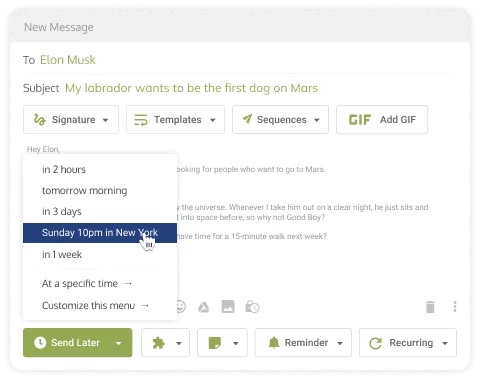
Pros
Right Inbox is a Gmail plugin that allows you to see who opens and clicks your emails from within your Gmail inbox.
It offers a bunch of other functionality, such as allowing you to set automated follow-up reminders, use pre-written templates, and schedule follow-up emails that are automatically canceled if the respondent replies.
It’s also extremely cheap, with a generous free tier and a team plan priced at just $6.95 per user per month.
Cons
While Right Inbox certainly has attractive pricing, it’s a sophisticated plugin rather than a dedicated email outreach tool. You’ll almost certainly have to use it alongside other tools for things like prospecting and managing prospect relationships.
29. Rebump.cc

Pros
Like Right Inbox app, Rebump is a Gmail plugin — although, unlike Right Inbox, it’s 100% focused on sending automated follow-up emails.
These automated emails are customized to appear as if you sent the email yourself. Alternatively, you can create custom “Bumps” for a more personalized approach.
All follow-up emails can be tracked and analyzed via your Rebump account.
Cons
Again, just like Right Inbox, Rebump is a fantastic (and cheap) plugin, but it’s far from an all-in-one email outreach tool. At the very least, anyone who’s serious about email outreach will also require a dedicated prospecting tool and a CRM, by which point it’s not that cheap anymore.
30. Mailtag

Pros
Mailtag is a tool for scheduling emails, automating follow-up emails, and tracking what happens after you click “send”.
It’s one of the cheapest email outreach tools going, priced at just $12.99 per user per month (or $9.99 if billed annually). And it lets you elevate your email signature by improving the design, adding a profile picture, and listing your contact information.
Mailtag also offers a 30-day refund guarantee.
Cons
You get what you pay for: Mailtag has some nice tools, but they’re pretty basic, meaning it’s certainly not an all-around email outreach tool. It might be suitable for total beginners, but you’ll need to upgrade to a more advanced platform sooner or later.
Conclusion: Which is the Best Email Outreach Tool for You?
In reality, there’s no such thing as the “best email outreach tool” for every single business.
A one-person startup with a tiny budget will naturally be looking for something very different from a multinational enterprise. And a sales director wants different features to a head of PR or marketing.
Still not sure which tool is right for you? Here’s my final verdict:
- Postaga: Best All-In-One Tool
- Hunter: Best for Email Collection & Verification
- Ninja Outreach: Best for Influencer Outreach
- SmartReach: Best for Large Sales Teams
- Reply.io: Best for Omnichannel Outreach
Free 14-Day Trial
Start building relationships now with your fully-featured 14-day trial!
How We Compare
Terms | Done-For-You Terms | Privacy | Write For Us | Press
© 2025 Postaga. All Rights Reserved. Made with 
